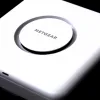Review NETGEAR BE18400 Tri-Band PoE 10G Insight Managed WiFi 7 Access Point (WBE758)
We tested the NETGEAR WBE758 access point, which is compatible with WiFi 7, a new and validated technology. It's rare for us to test WiFi 7, but this access point shattered some new records. This product is a beast, capable of reaching almost 4 Gbit/s at close range and close to 2 Gbit/s at long range on the new BE protocol. Compatible with the new BE standard (Wi-Fi 7), we can now double or even triple the throughput performance, resulting in the fastest Wi-Fi you've ever seen. The WBE758 is a tri-band access point that leverages the full potential of WiFi 7 with 320 MHz channel support on the 6 GHz band, providing much faster speeds than previous-generation WiFi 6.
Wi-Fi 7 is expected to provide faster speeds and greater bandwidth than Wi-Fi 6, which has only recently gained widespread adoption. Wi-Fi 7 will improve the usefulness of the third 6GHz channel, a feature introduced in the Wi-Fi 6E substandard. Wi-Fi 7, like its predecessor, operates across three frequency bands: 2.4GHz, 5GHz, and 6GHz. However, a significant advancement in Wi-Fi 7 is the extensive utilization of the 6GHz band, significantly enhancing the data pipeline compared to the implementation in Wi-Fi 6E. The trick lies into the fact that the key feature of Wi-Fi 7 is its capability to simultaneously use two channels (named MLO), thus combining 5GHz and 6GHz frequencies with a total bandwidth of 320MHz. This configuration is designed to substantially increase throughput, thereby facilitating higher data transmission speeds. If you have wired ethernet (LAN/WAN) you'll likely run it a 1 Gbps (1 Gigabit per second). With Wi-fi 7 you'll be able to fairly easily pass that value, without the usage of wires. The nearness of the 6GHz band to the 5GHz band enables the formation of a single, broader channel. This configuration minimizes latency and maximizes performance, an aspect central to Wi-Fi 7's Multi-Link Operation (MLO). In regions where the 6GHz band is unavailable due to regulatory constraints, Wi-Fi 7 adapts by offering an alternative configuration of two 5GHz channels (if your product supports that), each with a bandwidth of 240MHz. This setup still ensures enhanced speeds, aligning with Wi-Fi 7's focus on improving throughput across varying regulatory environments. The key elements to reach higher throughput are an increased channel bandwidth of 320 MHz, up to 16 spatial streams and 4096QAM modulation. 4K QAM modulation packs more data into transmissions, resulting in up to 20% higher peak data rates. Furthermore, with two additional features – Multi-Link Operation and Multi-RU Puncturing – the access point can deliver faster and more efficient wireless connections.
If you are in the same room as the AP (access point) or router, you can obtain fast wifi running well over 3000 Mbit/sec. But as this review will demonstrate, at 7-meter distances going through a wall you can still achieve a very comfortable 1500-2000 Mbit/sec on that BE WiFi 7 protocol, which is plenty fast for your gear like a gaming PC. This access point can quickly be hooked into your existing network and comes with exceptionally good (but somewhat difficult) cloud configuration access. Something else that is rather premium is the inclusion of a 10GbE port.
Of course, the is 802.11be AP is backwards compatible with anything WIFI; it has 802.11ax technologies, such as OFDMA, MU-MIMO, and spatial reuse, it by the way is 4x4 which allows you to enhance the possibilities of Wi-Fi6. A wireless access point functions similarly as a router extension. It's an Ethernet-connected device that gives wireless coverage to the surrounding region. You can dramatically increase your network coverage using a router and a collection of access points. However, not all access points are created equal. An access point poorly constructed or unsecured might be a big weakness in your network. This is terrible news if you're concerned about the security of your network. At the same time, you don't want to go without internet connectivity entirely.
The WBE758 certainly is a little unique; you can make use of Netgears professional cloud configuration and monitoring at no additional costs for four years (but granted the built in interface works just as well). You plug it in, connect it to the cloud with your smartphone, and you'll retrieve many options through an easy-to-use (but requires an understanding of network topology and configuration) web interface. Not only is that helping in ease of use, it also updates firmware to keep your hardware safe and stable.
- Indoor 802.11be (WiFi 7) access point
- Max. speed 2.4GHz: 1148Mbps
- Max. speed 5GHz: 2400Mbps
- Max. speed 6GHz: 4800 Mbps
- 2.4GHz is 4x4, 5GHz is 4x4, 6GHz is 4x4
- Remote management via Cloud is possible
- 10 Gigabit Ethernet
- Port Powered via 12V DC or 802.3at PoE+
- Ceiling or wall mounting
- Built-in 4x4x4 antenna 6dBi
- 23dBm/200mW transmit power
- WPA3 and WPA2-AES authentication
It can be difficult to keep your network secure, but what if you are a small firm with a smaller network or a prosumer with a comparable network at home? Keeping track of everything is typically entrusted to a single person, who is not always an IT specialist. Here's where Netgear comes in with a relatively easy-to-grasp network topology and management (albeit not for the novice).


